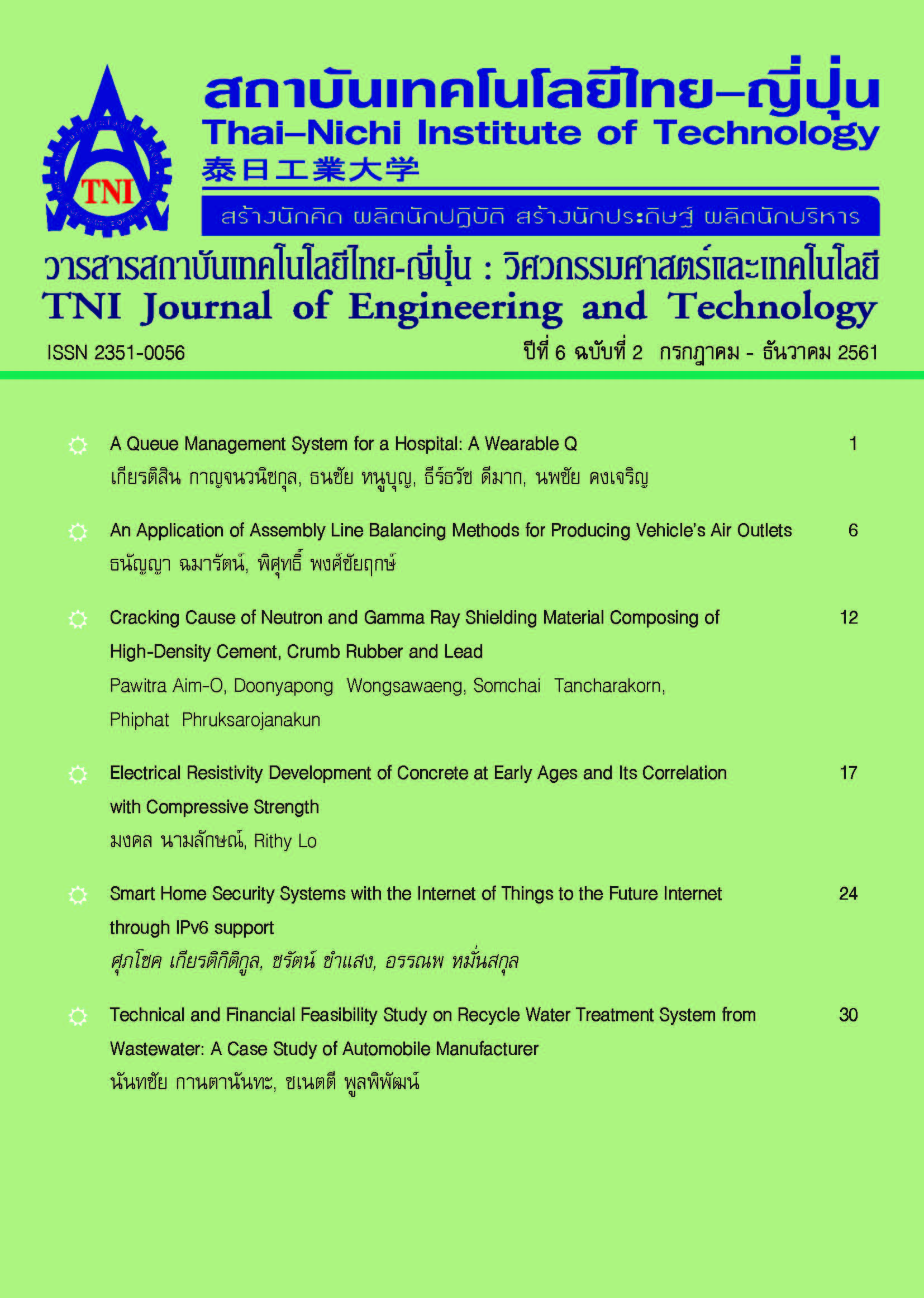Electrical Resistivity Development of Concrete at Early Ages and Its Correlation with Compressive Strength
Main Article Content
Abstract
The main purpose of this research was to study the electrical resistivity development of concrete in the first three days, by using a measurement tool developed in this work. Test variables included the water to binder ratio, the addition of superplasticizer, and the replacement of Portland cement by silica fume or fly ash, or both. Concrete properties measured included electrical resistivity as a function of time and 3-day compressive strength. Test results showed that the development curve of the electrical resistivity of concrete can be divided into two periods: 1) the setting period with slow change of resistivity and 2) the hardening period with a sharp increase of resistivity. Boundary between the two periods located at the point of resistivity drop. At the age of 3 day, it was found that the electrical resistivity of concrete strongly decreased with an increase in water to binder ratio, slightly decreased in the presence of fly ash and silica fume, and markedly increased with the use of superplasticizer. In general view, the 3-day compressive strength was found to have a linear correlation with the resistivity, indicating that there is a high possibility to predict the compressive strength of concrete by measuring its electrical resistivity.
Article Details
Article Accepting Policy
The editorial board of Thai-Nichi Institute of Technology is pleased to receive articles from lecturers and experts in the fields of engineering and technology written in Thai or English. The academic work submitted for publication must not be published in any other publication before and must not be under consideration of other journal submissions. Therefore, those interested in participating in the dissemination of work and knowledge can submit their article to the editorial board for further submission to the screening committee to consider publishing in the journal. The articles that can be published include solely research articles. Interested persons can prepare their articles by reviewing recommendations for article authors.
Copyright infringement is solely the responsibility of the author(s) of the article. Articles that have been published must be screened and reviewed for quality from qualified experts approved by the editorial board.
The text that appears within each article published in this research journal is a personal opinion of each author, nothing related to Thai-Nichi Institute of Technology, and other faculty members in the institution in any way. Responsibilities and accuracy for the content of each article are owned by each author. If there is any mistake, each author will be responsible for his/her own article(s).
The editorial board reserves the right not to bring any content, views or comments of articles in the Journal of Thai-Nichi Institute of Technology to publish before receiving permission from the authorized author(s) in writing. The published work is the copyright of the Journal of Thai-Nichi Institute of Technology.
References
ASTM C39 / C39M - 17b, “Standard Test Method for Compressive Strength of Cylindrical Concrete Specimens,” ASTM International: West Conshohocken, PA, 2017.
“Testing Hardened Concrete Compressive Strength of Test Specimens,” BS EN 12390-3, 31-May-2009.
B. Dong, J. Zhang, Y. Wang, G. Fang, Y. Liu, and F. Xing, “Evolutionary trace for early hydration of cement paste using electrical resistivity method,” Construction and Building Materials, vol. 119, pp. 16–20, Aug. 2016.
X. Wei, L. Xiao, and Y. Liao, “Early Age Properties of Cementitious Materials by Electrical Resistivity Measurement,” Journal of Wuhan University of Technology-materials Science Edition., vol. 25, pp. 641–644, Aug. 2010.
L. Xiao and X. Wei, “Early age compressive strength of pastes by electrical resistivity method and maturity method,” Journal of Wuhan University of Technology-materials Science Edition., vol. 26, no. 5, pp. 983–989, Oct. 2011.
X. Wei, L. Xiao, and Z. Li, “Prediction of standard compressive strength of cement by the electrical resistivity measurement,” Construction and Building Materials, vol. 31, pp.341-346, 2012.
ธเนศ ทายะบวร และ มงคล นามลักษณ์, “กำลังอัดและการพัฒนาความต้านทานไฟฟ้าของซีเมนต์มอร์ตาร์ผสมซิลิกาฟูมและเถ้าลอย,” ในเรื่องนวัตกรรมอาคาร, โรงแรม ไมด้า ทวารวดี แกรนด์ นครปฐม, 2559, หน้า 116–124.
Wei Xiaosheng and Li Zongjin, “Early Hydration Process of Portland Cement Paste by Electrical Measurement,” Journal of Materials in Civil Engineering, vol. 18, no. 1, pp. 99–105, Feb. 2006.
i. B. Topçu, T. Uygunoglu, and i. Hocaoglu, “Electrical conductivity of setting cement paste with different mineral admixtures,” Construction and Building Materials, vol. 28, no. 1, pp. 414–420, Mar. 2012.
J. Liu, K. Wang, Q. Zhang, F. Han, J. Sha, and J. Liu, “Influence of superplasticizer dosage on the viscosity of cement paste with low water-binder ratio,” Construction and Building Materials, vol. 149, pp. 359–366, Sep. 2017.
F. Rajabipour and J. Weiss, “Electrical conductivity of drying cement paste,” Materials and Structures, vol. 40, no. 10, pp. 1143–1160, Dec. 2007.
W. Wongkeo, P. Thongsanitgarn, A. Ngamjarurojana, and A. Chaipanich, “Compressive strength and chloride resistance of self-compacting concrete containing high level fly ash and silica fume,” Materials & Design, vol. 64, pp. 261–269, Dec. 2014.
M. B. C. Mangane, R. Argane, R. Trauchessec, A. Lecomte, and M. Benzaazoua, “Influence of superplasticizers on mechanical properties and workability of cemented paste backfill,” Minerals Engineering, vol. 116, pp. 3–14, Jan. 2018.


